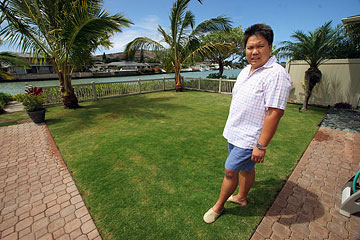THE GREEN HOUSE

DENNIS ODA / DODA@STARBULLETIN.COM"My neighbors spend an average of $350 to $500 a month on utilities, but I only average about $140. It was about the money first, but being green has been great." -- Frank Igno
Frank Igno is selling his energy-efficient home at 520 Lunalilo Home Road #520 in the Hawaii Kai peninsula. Among green features he has added are solar power, energy-efficient appliances, low-flush toilets, water-conserving showers, tinted and solid double-paned windows, timed water sprinklers, an epoxied and vented garage, salt water-tolerant grass and well-insulated walls. In addition, he has positioned the house to take advantage of Hawaii's trade winds. CLICK FOR LARGE |
|
Turning green to gold
A Hawaii Kai resident is capitalizing on one of the hottest trends in residential real estate
» Hawaii Kai homeowner has a green thumb
» Big Island residents describe what it's like to live green
HAWAII'S OFF-GRIDDERS, those who choose to live a green lifestyle away from the network of communication wires, power and water lines that define civilization for many, have long embraced eco-consciousness. Yet, the green movement remained steeped in mystery for many.
New products and lowered costs have made living green more appealing for people and has brought the movement mainstream as people try to do their part to avoid global warming and to bring down their own rising fuel costs.
Lack of knowledge has been the greatest challenge to the spread of green, but that's changing. This summer, the U.S. Green Building Council will introduce a green LEED rating system for residential homes, thereby setting a standard that demystifies green living for consumers.
LEED, which stands for leadership in energy and environmental design, is the recognized standard for measuring building sustainability.
One day, sooner than many think, experts anticipate that green will move beyond the way that people live to shape how they buy and sell their homes.

